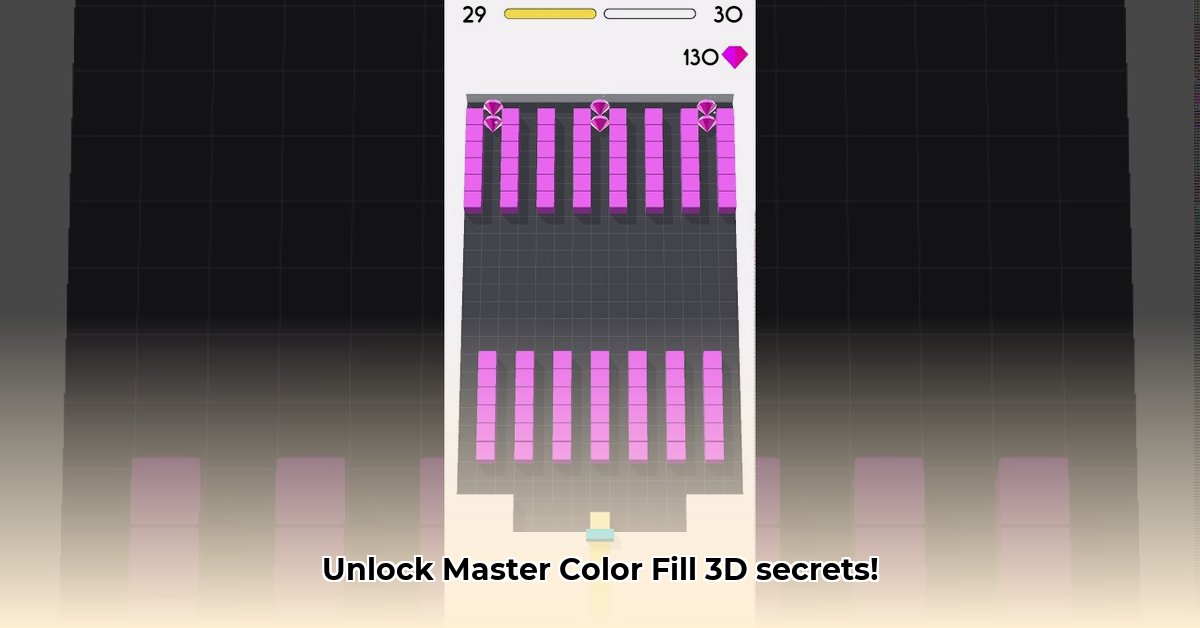
Color Fill 3D: A Competitive Analysis
Color Fill 3D, a mobile puzzle game, distinguishes itself within a saturated market. This report analyzes its competitive landscape, player engagement strategies, and potential for future growth, offering actionable recommendations for sustained success. The analysis focuses on identifying key strengths and weaknesses, outlining opportunities, and addressing potential threats. While this report lacks specific quantitative data at this stage, the framework allows for seamless integration of such data upon acquisition.
ColorFill 3D: Gameplay and Market Positioning
Color Fill 3D presents a deceptively simple premise: filling a grid with color. However, mastering the game requires strategic thinking and efficient resource management. The core gameplay loop, characterized by satisfying visual effects and intuitive controls, creates an engaging and relaxing experience. But what truly sets Color Fill 3D apart from competitors like Block Puzzle and Stack Ball? A comprehensive competitive analysis—comparing metrics such as level count, average session playtime, and player retention rates—is crucial to definitively answer this question. This analysis will further illuminate Color Fill 3D's unique value proposition. Does it offer a novel approach to level design or unique game mechanics? The answers to these questions will define its competitive edge.
Key Factors Driving Player Engagement
Sustained player engagement is paramount for any game's long-term success. How can Color Fill 3D achieve this? Analyzing player reviews and retention rates will reveal critical patterns and trends. Short-term improvements could include enhanced in-game tutorials and more helpful tips. Long-term strategies might involve incorporating leaderboards to foster competition or integrating social features to build a vibrant player community. Imagine the potential impact of players sharing scores and strategies – a thriving community significantly extends a game's lifespan. However, is the current reward system sufficient to maintain consistent player engagement? This requires further investigation.
A Roadmap for Growth: Strategic Recommendations
Data-driven decisions are paramount for optimizing Color Fill 3D's performance. A/B testing, comparing different versions of the game with varied level designs and challenges, provides a powerful tool for identifying effective strategies. Marketing efforts must focus on visually compelling gameplay videos highlighting the game's unique aesthetic and engaging gameplay experience. Targeted advertising campaigns, utilizing data-driven insights to reach specific demographics, are crucial for expanding the player base. But how can the game's unique features be effectively communicated to attract new players? This question represents a critical marketing challenge.
Strategic Goals: A Timeline
| Stakeholder | Short-Term Goals (0-1 year) | Long-Term Goals (3-5 years) |
|---|---|---|
| Developers | Implement A/B testing; refine UI/UX; improve in-game tutorial and hints. | Develop a consistent content update schedule; explore new game modes and features. |
| Marketing Team | Produce high-quality marketing videos; initiate targeted advertising campaigns. | Build a strong social media presence; actively engage with the player community. |
| Players | Enhanced player experience through intuitive gameplay and engaging level design. | Continued support and engagement through regular content updates and community events. |
Addressing Challenges and Mitigating Threats
The mobile gaming market is intensely competitive. High player churn poses a significant threat. To mitigate this, consistent content updates—introducing new levels, challenges, and features—are vital. Maintaining a strong social media presence and actively engaging with players builds loyalty. Continuously highlighting Color Fill 3D's unique selling points amidst intense competition is crucial. Thorough testing throughout development minimizes the risk of technical issues impacting user experience. Finally, careful consideration of in-app purchases and advertising is needed to balance monetization with player satisfaction. What strategies can best address the challenge of balancing monetization with maintaining a positive player experience? This requires careful planning and execution.
Conclusion: Realizing Color Fill 3D's Potential
Color Fill 3D possesses considerable potential for success in the mobile puzzle game market. A data-driven approach, coupled with consistent improvements based on player feedback and market analysis, is essential. Leveraging the game's strengths while addressing weaknesses will ultimately define its long-term success. The developers' capacity to adapt and respond effectively to evolving trends will shape the game's future. This journey to market leadership requires persistent refinement and innovation.
How to Improve Color Fill 3D Game Retention Rates
Understanding player behavior is crucial. Analyzing data (playtime, level completion rates, in-app feedback) reveals valuable insights into why players might abandon the game. Is the difficulty curve too steep or too shallow? Are the rewards frequent and engaging enough? The answers to these questions are vital.
Optimizing Gameplay and Visuals
Several key areas require attention:
- Difficulty Curve: A well-designed difficulty curve ensures players are challenged but not frustrated.
- Reward System: A satisfying reward system, including unlockable content, boosts engagement.
- Intuitive Controls: Simple, responsive controls enhance the player experience.
- Progression System: A clear progression system with visible milestones motivates players.
- Color Palette: A vibrant, harmonious color palette elevates the visual experience.
- Visual Feedback: Clear visual cues guide players and provide immediate feedback.
- Overall Aesthetics: Maintaining a polished and consistent visual style is important.
Regular Updates and Competitive Analysis
Regular updates, including new content, community engagement initiatives, and bug fixes, are paramount. A continuous competitive analysis, examining successful competitor games, is vital for identifying best practices and areas for improvement. What are the key takeaways from analyzing successful competitor games? This information guides strategic design decisions.
⭐⭐⭐⭐☆ (4.8)
Download via Link 1
Download via Link 2
Last updated: Sunday, June 08, 2025